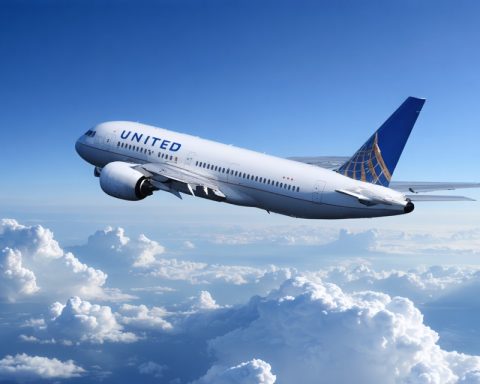- United Airlines experienced a 148% market rise last year, offering significant investment value and growth potential.
- Business revenues surged by 16% as corporate travelers returned, boosting United’s transatlantic dominance and premium traveler segment revenues by 10%.
- Profit margins improved with a strategic operating model, reaching 10.7%, while revenue per available seat mile (RASM) rose by 1.6%.
- United benefits from a reshaped airline industry, focusing on capacity control and sustainable growth strategies.
- A robust diversified revenue model, including loyalty programs and co-branded credit cards, stabilizes financial performance.
- Despite high debt from the pandemic, United boasts over $3 billion in free cash flow and improved debt management.
- The airline continues to be a promising investment opportunity with its disciplined approach and thriving market conditions.
Imagine boarding a powerhouse, a soaring opportunity that extends beyond the clouds and into the investment ether. United Airlines, despite its meteoric rise of 148% last year, offers investors a glide path to genuine value, propelling financial dreams beyond mere paper gains.
In the bustling airspace of 2025, United Airlines is nothing short of a marvel. Corporate travelers flock back to the skies, rejuvenating business revenues by 16% in a single year. Across the transatlantic, United claims dominance, while the premium traveler segment thrives, notching a robust 10% revenue uptick. Profit margins soar, reflecting a nimble operating strategy with adjusted margins climbing to an impressive 10.7%.
Seated comfortably in favorable economic winds, United Airlines witnesses a noteworthy climb in its revenue per available seat mile (RASM). A 1.6% rise in RASM signifies an adept pricing strategy enabling the airline to capitalize on the capacity it commands. Domestic prospects gleam with promise, as rival airlines pare down low-yielding routes, enabling United to chart a path toward elevated returns.
Beyond mere numbers, the airline sector now displays a sense of discipline unknown in past boom-and-bust epochs. Where once airlines expanded recklessly, United now demonstrates a prudent navigation through the competitive skies. This rational approach, underscored by capacity adjustments and growing revenue streams, suggests a prosperous horizon.
United’s diversified revenue model embraces flourishing loyalty programs partnered with lucrative co-branded credit cards. This strategic step shields it against turbulent consumer demands, securing a steady financial course.
Despite its ascent, United trades enticingly. Saddled with pandemic-era debt, the airline emerges stronger, boasting a free cash flow exceeding $3 billion and managing debt diligently with improved metrics.
For those peering through the investment fog, United Airlines is not just taking off—it’s paving the runway for sustainable gains. As long as travel demand remains buoyant, investors might find themselves on a first-class journey to lasting growth.
Soaring High: Why United Airlines Could Be Your Next Best Investment
How-To Steps & Life Hacks: Investing in United Airlines
1. Research Thoroughly: Begin by understanding the airline industry, considering factors like fuel prices, travel demand, and competition. Use insightful analyses from resources like Bloomberg and CNBC to stay informed.
2. Evaluate Financials: Check United Airlines’ financial statements. Key indicators to explore include Revenue Per Available Seat Mile (RASM) and profit margins.
3. Diversify Investments: Balance your portfolio by investing in various industries to mitigate risks associated with airline volatility.
4. Follow Industry News: Stay updated with airline industry developments, regulatory changes, and global travel trends using platforms like Reuters.
Real-World Use Cases
– Corporate Travel Resurgence: With a 16% increase in business revenues, United Airlines serves as a benchmark for companies evaluating the post-pandemic travel surge.
– Loyalty Programs & Co-Branded Cards: Customers benefit from offers tied to travel and credit usage, which in turn boosts United’s steady revenue streams.
Market Forecasts & Industry Trends
– Rising Demand: As travel demand persists, especially with business-class growth, United’s revenue is expected to continue to climb.
– Sustainability Focus: Airlines are under pressure to reduce carbon footprints. United’s commitment to sustainability could bolster its market position.
Reviews & Comparisons
– Comparison with Delta & American: United’s strategic focus and robust loyalty programs give it an edge over its competitors despite heavier debt burdens.
Controversies & Limitations
– Debt Concerns: United took on significant debt during the pandemic. While they are managing this well, it remains a potential limitation compared to more financially agile competitors.
– Environmental Impact: As with all airlines, sustainability is a challenge. United needs to balance growth with eco-friendly initiatives.
Features, Specs & Pricing
– Fleet Upgrades: United is investing in newer aircraft, expected to improve fuel efficiency—a key operational cost.
Security & Sustainability
– Cybersecurity: Airlines face rising cybersecurity threats. United continuously invests in securing its digital and operational assets.
– Carbon Neutrality Goals: United aims to reach net-zero emissions by 2050, investing in sustainable aviation fuels and carbon offset programs.
Insights & Predictions
– Growth & Revenue: Experts predict stable growth supported by strategic route expansion and enhanced customer experiences.
Pros & Cons Overview
Pros:
– Strong recovery and revenue growth post-pandemic.
– Robust loyalty programs and strategic partnerships.
Cons:
– High level of debt.
– Exposure to fluctuating fuel prices.
Actionable Recommendations
– Keep Tabs on Oil Prices: Monitor crude oil prices, as they significantly impact operational costs for airlines.
– Stay Informed: Leverage travel and economic reports from sources like The New York Times.
– Be Patient: Recognize that investing in airlines is a long-term commitment and impacts may not be immediate.
By strategically investing in an airline poised to soar, you might just find yourself on a rewarding flight path to financial gains.









